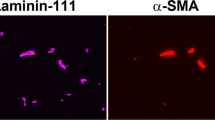Abstract
Hypoxic tissue has been observed in the surrounding areas of the ischemic core following cerebral infarction. The underlying mechanisms for this potentially reversible ischemic region remain to be determined. In this study, we generated permanent brain ischemia (PI) and reperfusion after inducing ischemia for 1.5 h (ischemia–reperfusion or IR) in a rat model of middle cerebral artery occlusion. Using immunofluorescence, we observed hypoxic tissue in ischemic brains and assessed microvessel density in and surrounding the hypoxic tissue. We found that the hypoxic tissues were observed at 1 and 3 days in PI rats and at 1, 3, 7, and 14 days in IR rats. The hypoxic tissue gradually decreased over time. The microvessel density increased in a time-dependent manner in focal brain ischemic tissue in PI and IR rats. Furthermore, IR induced a significant increase in microvessel density when compared with PI rats (P < 0.05). Microvessel density surrounding hypoxic tissue was significantly higher when compared with within the hypoxic tissue (P < 0.05). These data demonstrate that hypoxic tissue may exist for a long period (14 days) following brain IR and indicate that hypoxic tissue usually existed with low microvessel density. Furthermore, the duration of hypoxic tissue was partially dependent on the degree of microvessel proliferation.




Similar content being viewed by others
References
Astrup J, Siesjo BK, Symon L (1981) Thresholds in cerebral ischemia—the ischemic penumbra. Stroke 12:723–725
Donnan GA, Fisher M, Macleod M, Davis SM (2008) Stroke. Lancet 371:1612–1623
Nunn A, Linder K, Strauss HW (1995) Nitroimidazoles and imaging hypoxia. Eur J Nucl Med 22:265–280
Thored P, Wood J, Arvidsson A, Cammenga J, Kokaia Z, Lindvall O (2007) Long-term neuroblast migration along blood vessels in an area with transient angiogenesis and increased vascularization after stroke. Stroke 38:3032–3039
Song HC, Bom HS, Cho KH, Kim BC, Seo JJ, Kim CG, Yang DJ, Kim EE (2003) Prognostication of recovery in patients with acute ischemic stroke through the use of brain SPECT with Technetium-99 m-labeled metronidazole. Stroke 34:982–986
Wang YD, Li XP, Li M, Liu S, Lu XP, Peng Y, Huang RX (2010) Relationship between cerebral hypoxic tissue volume and prognosis after stroke. Eur Neurol 63:52–59
Wang YD, Liu S, Li XP, Shen QY, Li M, Yan ZW, Zhang H, Lu XP, Huang RX (2007) Hypoxic imaging with 99mTc-HL91 STSPECT in patients with cerebral infarction. Guo Ji Nao Xue Guan Bing Za Zhi 15:33–37
Croll SD, Wiegand SJ (2001) Vascular growth factors in cerebral ischemia. Mol Neurobiol 23:121–135
Longa EZ, Weinstein PR, Carlson S, Cummins R (1989) Reversible middle cerebral artery occlusion without craniectomy in rats. Stroke 20:84–91
Marti HJ, Bernaudin M, Bellail A, Schoch H, Euler M, Petit E, Risau W (2000) Hypoxia-induced vascular endothelial growth factor expression precedes neovascularization after cerebral ischemia. Am J Pathol 156:965–976
Ardelt AA, Anjum N, Rajneesh KF, Kulesza P, Koehler RC (2007) Estradiol augments peri-infarct cerebral vascular density in experimental stroke. Exp Neurol 206:95–100
Spratt NJ, Ackerman U, Tochon-Danguy HJ, Donnan GA, Howells DW (2006) Characterization of fluoromisonidazole binding in stroke. Stroke 37:1862–1867
Saita K, Chen M, Spratt NJ, Porritt MJ, Liberatore GT, Read SJ, Levi CR, Donnan GA, Ackermann U, Tochon-Danguy HJ, Sachinidis JI, Howells DW (2004) Imaging the ischemic penumbra with 18F-fluoromisonidazole in a rat model of ischemic stroke. Stroke 35:975–980
Krupinski J, Stroemer P, Slevin M, Marti E, Kumar P, Rubio F (2003) Three-dimensional structure and survival of newly formed blood vessels after focal cerebral ischemia. Neuroreport 14:1171–1176
del Zoppo GJ, Mabuchi T (2003) Cerebral microvessel responses to focal ischemia. J Cereb Blood Flow Metab 23:879–894
Hayashi T, Noshita N, Sugawara T, Chan PH (2003) Temporal profile of angiogenesis and expression of related genes in the brain after ischemia. J Cereb Blood Flow Metab 23:166–180
Thored P, Arvidsson A, Cacci E, Ahlenius H, Kallur T, Darsalia V, Ekdahl CT, Kokaia Z, Lindvall O (2006) Persistent production of neurons from adult brain stem cells during recovery after stroke. Stem Cells 24:739–747
Kovacs Z, Ikezaki K, Samoto K, Inamura T, Fukui M (1996) VEGF and flt expression time kinetics in rat brain infarct. Stroke 27:1865–1872
Wang YD, Pan JR, Qiu Y, Li XP, Li M, Peng Y (2009) Long-term existence of cerebral hypoxic tissue in a rat model of cerebral ischemia–reperfusion injury. Neural Regen Res 4:371–376
Acknowledgments
The authors thank Prof. Cameron J. Koch (University of Pennsylvania, PA) for his kind gifts (EF5 and Cy3-conjugated ELK3–51 monoclonal antibodies and Cy3- ELK3-51 competed solution). This work was supported by Science and Technology Planning Project of Guangdong Province, China (No. 2007B031502007) to Y. Wang.
Author information
Authors and Affiliations
Corresponding author
Additional information
J. Pan and Y. Li contributed equally to this work.
Rights and permissions
About this article
Cite this article
Pan, Jr., Li, Y., Pei, Z. et al. Hypoxic tissues are associated with microvessel density following brain ischemia–reperfusion. Neurol Sci 31, 765–771 (2010). https://doi.org/10.1007/s10072-010-0441-z
Received:
Accepted:
Published:
Issue Date:
DOI: https://doi.org/10.1007/s10072-010-0441-z



